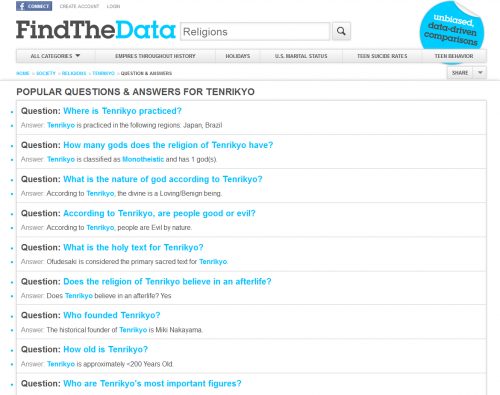Wow, it’s been some time since I’ve contributed to TR! I apologize for my absence.
Some weeks ago, I stumbled upon a page entitled “Popular Questions & Answers for Tenrikyo” on FindTheData.org. Although it provides a handy list of Q&A, I found it to contain some information I would qualify as misconceptions at best.
Human beings: Not evil by nature
The most serious objection I have is against the following:
Question: According to Tenrikyo, are people good or evil?
Answer: According to Tenrikyo, people are Evil by nature.
This is an inaccurate representation of Tenrikyo beliefs regarding human nature. The following verses from the Ofudesaki ought to make this clear:
Looking all over the world and through all ages, I find no one who is evil. / Among all humankind, there is no one who is evil. It is only a bit of dust stuck on.
1:52–53
These verses from Tenrikyo’s primary Scripture claim human beings are not evil by nature. Granted, human beings have done (and obviously still do) all kinds of despicable things throughout history.
Yet whereas people may indulge in actions that are unmistakably evil, it is explained that this is not because human beings are evil per se, but because of “dust”—a metaphor for mistaken uses of the mind or modes of consciousness—which prevent people from behaving in ways that are best representative of their “true” nature.
Tenrikyo: monotheist?
FindTheData.org also labels Tenrikyo as “monotheist.” While I would readily accede that Tenrikyo adherents mostly seem to say they believe in Tenri-O-no-Mikoto and no other god(s), to the best of my knowledge, there is nothing in Scripture that conclusively places Tenrikyo in the monotheist category.
While the label “monotheist,” isn’t necessarily inaccurate, this issue isn’t exactly cut-and-dried as one may wish to believe. (I have previously written on this very subject here.)
There is credible evidence that some early followers understood the ten sacred names that are each given to what is known today as the “ten aspects of the complete providence” as ten different deities.
Holy sites
Another minor objection I have is how “Tenri-shi, Japan” is identified as a holy site in Tenrikyo. I am quite confident in saying that the entire municipality known as “Tenri” is not considered holy by Tenrikyo adherents.
A more accurate statement would be, “Tenrikyo’s main holy site is Jiba, situated within the Main Sanctuary of Tenrikyo Church Headquarters and located in Tenri-shi, Japan.”
Tenrikyo organization
Tenrikyo’s organization type is characterized as “General Followers and Spiritual Mentors.” Though this is arguably what the average adherent aspires for, I would characterize Tenrikyo’s present organization as “hierarchical.”
Positions of authority
FindTheData.org merely identifies “Honseki” as a position of authority.
Historically, the position of authority known as “Honseki” only existed between March 25, 1887 and June 9, 1907.
While there appears to have been an attempt to officially name Motoyoshi Ibaragi as the second Honseki as well as claims that Naraito Ueda was allegedly meant to fill the role but was prevented from fully doing so, the orthodox understanding is that Izo Iburi was the only person to ever hold such a position.
Actual positions of authority in Tenrikyo include:
- Shinbashira (“central pillar,” i.e. patriarch of the Tenrikyo faith)
- Honbu-in (headquarters executive official)
- Honbu-fujin (headquarters female official)
- Honbu-jun’in (headquarters senior official)
- Honbu-tsumein (headquarters attendant officials)
- Honbu-seinen (headquarters male junior official)
- Honbu-joshi-seinen (headquarters female junior official)
Other positions include:
- Omotetoryo (Director-in-Chief of Administrative Affairs)*
- Uchitoryo (Director-in-Chief of Religious Affairs)*
*A Honbu-in is appointed to these positions to serve three-year-terms
- Kyokucho (diocese superintendent of one of 47 dioceses for every prefecture in Japan)
- Chocho (bishop of one of five overseas “mission headquarters”)
- Daikyokaicho (grand church head minister)
- Kyokaicho (head minister)
- Yaku-in (church officer)
- Fukyoshocho (fellowship/mission station head)
Salvation in Tenrikyo
Also on FindTheData.org:
Question: How do I achieve salvation according to Tenrikyo?
Answer: According to Tenrikyo, salvation can be achieved in the following manner: The Joyous Life in Tenrikyo is defined as charity and abstention from greed, selfishness, hatred, anger and arrogance.
Arguably, what is given above isn’t really what you can call an answer. According to the Ofudesaki, salvation is to be achieved in one or more of the following ways:
- Through God’s efforts to make the minds of everyone in the world become spirited (1:8; 3:142)
- By completely sweeping dust away from the Residence and the minds of everyone in the world (2:18–20; 3:98; 17:50–51)
- Through efforts made to save others (3:47; 12:91–94)
- Through the performance of the Service (4:93; 7:83; 8:3; 12:61)
- By becoming of a sincere mind or having one’s sincerity accepted (6:118; 7:84; 8:3; 8:55; 13:71)
Miscellany
Lastly, some closing observations regarding the Tenrikyo entry on FindTheData.org:
- “Important passages”: This really isn’t a quote from Scripture.
If I were to suggest some, they would be Ofudesaki 3:47; 8:4; 12:91–94; 14:25; 14:35 and Song Seven, verse 6.
- “Rules and Standards”: It is a bit of a challenge to think of anything that would fit here since Tenrikyo doesn’t really readily offer a fixed list of rules and regulations but rather a set of broad principles that are to be applied in a multitude of situations occurring in one’s daily life. This happens to a topic that’s been on my mind recently but I haven’t had much opportunity to wrap my thoughts around fully yet.
In any case, I would suggest “Early rising, honesty, and (hard) work.” Also: “Sweeping the heart/mind of dust” and list of eight dusts.
- “Holidays: Hinokishin Day, Greenery Day.” This is an understandable misconception. Tenrikyo does happen to observe “Hinokishin Day” on April 29 (which is no longer known as Greenery Day, but now called “Showa Day”), but it is arguably lesser in importance compared to other days in Tenrikyo.
Days that are greater in importance would be New Year’s Day, the Spring Grand Service (Jan. 26 in Jiba), Oyasama’s Birthday (April 18), and the Autumn Grand Service (Oct. 26 in Jiba).
- This is what’s written for “Weekly Gatherings or Observances”: “Observe the brothers and sisters of the path who have looked forward.” HUH? I have absolutely no idea what this statement is supposed to mean.
Tenrikyo tends to have gatherings that come in monthly cycles, the most important being the tsukinami-sai (monthly service). The “monthly service” in the months of January and October are referred to as taisai (grand services).
Some churches have monthly gatherings called “sekkyobi,” literally, “sermon day.” I assume each church has their own set way to conduct it, but the ones I’ve attended tend to give younger members the opportunity to participate in a monthly service practice and give a testimonial (speech) on their faith.
- “Recruitment Methods: None.” Hmm… You mean you haven’t had a Tenrikyo adherent knock on your door before?
Although Tenrikyo missionaries may not be as active today as they were in the past, there is a yearly “Nioigake Day” and a few “Missionary Houses” where followers devote at least a year propagating the faith in a community.
After a quick review of entries on other faiths on this site, I have to conclude that the information FindTheData provides is iffy at best and arguably misrepresentative in a number of instances. While I can understand the wish for placing the world’s faiths into neat little categories; it really is an almost impossible task to reduce any faith system into a few bite-size chunks of information.












